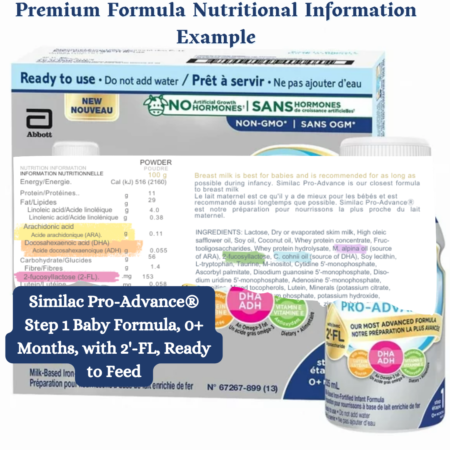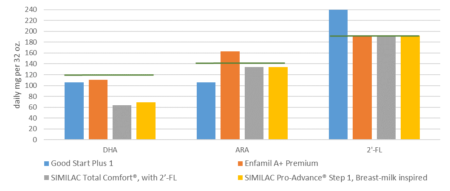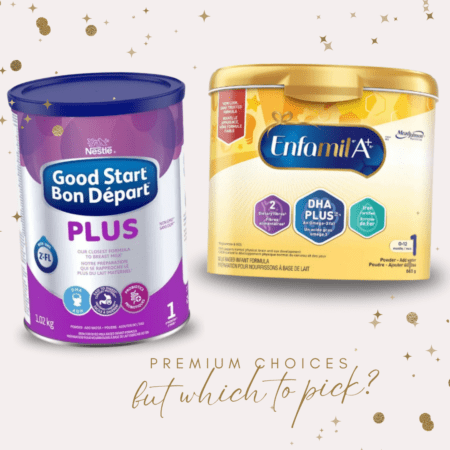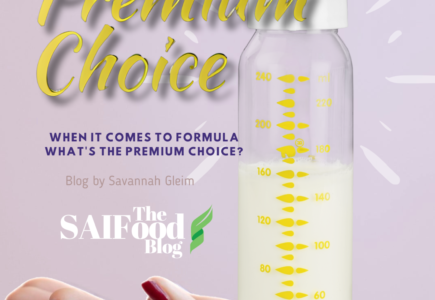This week, Savannah continues to reflect on her struggle to navigate the overwhelming world of baby formula, focusing this time on understanding formula ingredients and quantities. She discusses the myriad of options in the formula aisle, ranging from basic to premium products, each claiming unique benefits for babies.
Previously I poured my frustrations out in a blog about the struggles I had as a new parent on finding useful and helpful information on baby formula. This week, my struggle bus continues, as I share what is readily available in the form of literature on formula ingredients and the quantities needed. Here is a spoiler, there wasn’t much.
Basic to Premium, the formula aisle has you covered
In the baby aisle, every brand is selling something ‘special’ because your baby is special. You will find there is a whole host of words that jump out like pro and advances, there are packages with gold and silver detail, and they all begin to look the same. Perhaps this is the result of being overwhelmed, or the fact that at first, I didn’t know what I was looking for.
What you find in the formula aisle is a mixture of entry-level formulas that are safe and meet the approved formulation, and the ‘premium’ products. These premium products offer extra ingredients or niche formulas like iron-fortified, gentle formulas, plant-based, organic, and so forth. Until your baby arrives, you don’t know what you will need. So my suggestion is to be informed about what sets the basics and premiums apart. It’s obvious what the benefits of lactose-sensitive formulas or iron-fortified are, but other ingredients are advertised as improving brain and growth development in the premium formulas. The ingredients that were promoted to such benefits are 2′-fucosyllactose (2’-FL)[1], arachidonic acid (ARA), and docosahexaenoic acid (DHA). Since I am not a doctor or scientist, these ingredients required further investigation on my part. Below is a very simple explanation of the benefits of these three premium ingredients.
“Premium” Ingredients
2′-Fucosyllactose (2’-FL) is present in breast milk and it is a human milk oligosaccharide (HMO) that helps build a stronger immune system. Its inclusion in infant formula has been found to change an infant’s “microbiome in the direction of breastfed infants”. An infant’s gut microbiome is important not only for helping break down foods and synthesize vitamins and hormones, but also it “influences immunological, endocrine, and neural pathways”. There have not been any adverse effects reported of the inclusion of 2’-FL.
Arachidonic acid (ARA) is a fatty acid (type of omega-6) found in breast milk and is “critical for infant” growth and brain development. It is needed for “regulating immune function, inflammation, fertility and blood flow”. As a fatty acid, our bodies can’t make ARA for themselves, but we benefit from having it in our diets so that our body can use it to carry out the functions it needs. The latest research “has demonstrated clearly that ARA is an essential fatty acid required for body and brain growth as well as optimal neural function.” Knowing this, I was shocked it wasn’t required in all formulas.
Lastly, docosahexaenoic acid (DHA) is another essential fatty acid (type omega-3) of breast milk. It is required for normal brain function as an adult. “DHA accumulates in the brain and retina of the eye and plays an important role in neural and vision development.” Its inclusion is widely recognized for its benefits on brain growth and functional development, knowing this, it was a no-brainer for me as to whether I would look for it in a formula.
Neither ARA nor DHA are mandatory in formulas sold in Canada. For omega fatty acids, instead, formulas are required to have both linoleic and linolenic acids. However, even Health Canada states on their webpage that there are questions as to whether an infant can convert these acid chains.
Let’s talk quantities and labels
All formulas found in the infant aisle are approved, safe, and meet the standards of nutrition, so I couldn’t go wrong with my choice. Knowing this, the ingredients were no longer a struggle to understand, but the QUANTITIES of those ingredients were. Each brand offers different amounts, although only by the tiniest amounts in most cases, so what is the right amount of each? They all meet the requirements of what is needed for vitamins and required fortification, therefore I decided not to focus on those, but exclusively on the premium products. Would an extra 1 mg of ARA per 100 ml of dilution be absorbed and beneficial to my baby, or would I just be paying for ARA-enriched pee-soaked diapers?
 Since ARA, DHA, and 2’-FL are not mandatory in Canadian formulas, finding the ‘right’ quantities was impossible. I did quickly learn that DHA as of 2020 was mandatory in EU infant formulas, giving me a range of 20-50 mg/ 100 kcal. Using NIH’s 100kcal/kg/day, let’s take the example of a 2-month-old infant of 6 kg baby would need between 120-300 mg of DHA per day, which is a large range. If the recommended formula is 28-30 oz. per day for the formulas available to me, at 20mg/100 kcal, the formulas ranged from needing to feed 35-61 oz. of formula a day. While I might not know exactly how much DHA is needed, if it was of the upper range of the EU mandate, I was best to go with the formula with the most DHA present.
Since ARA, DHA, and 2’-FL are not mandatory in Canadian formulas, finding the ‘right’ quantities was impossible. I did quickly learn that DHA as of 2020 was mandatory in EU infant formulas, giving me a range of 20-50 mg/ 100 kcal. Using NIH’s 100kcal/kg/day, let’s take the example of a 2-month-old infant of 6 kg baby would need between 120-300 mg of DHA per day, which is a large range. If the recommended formula is 28-30 oz. per day for the formulas available to me, at 20mg/100 kcal, the formulas ranged from needing to feed 35-61 oz. of formula a day. While I might not know exactly how much DHA is needed, if it was of the upper range of the EU mandate, I was best to go with the formula with the most DHA present.
In a peer-reviewed article, I found an ARA recommendation for 140 mg/day in the first few months of an infant’s life. While there are few explicit recommendations online, I chose not to focus on what is estimated from breastmilk, as they are based on their diet and culture, and also do not necessarily reflect the recommended but the average available in breast milk. The WHO recommends at 6 months “190 mg/d ARA and 130 mg/d DHA”, which only consumed me more, should DHA and ARA be equal parts or one greater than the other?
It appears that there is a need not only for more DHA and ARA clinical trials to suggest the delaying recommended intake, but also for 2’FL. Of the publications available, it is published that 0.2 g /L added to infants’ formula “brings it closer compositionally to human milk, but also functionally”. To me this was the final confirmation I needed, that I would make sure to find a formula that had all three of these premium ingredients. So in order to achieve the roughly 0.168 g – 0.18 g of 2’FL a day for a 2-month-old, feeding on 28-30 oz. of formula, I would need a dilution of 18.6 mg – 21.4 mg/100ml listed on the nutrient label.
Pick one already
I broke out my spreadsheet skills and tracked all the premium formulas I could at my local grocer. It turns out the top-shelf products are very similar, like Coke or Pepsi, it’s more where your brand allegiance lays. As a new mom, I had none. At first, I thought I would get the perfect ratio of DHA, ARA, and 2’-FL, but it turned out there wasn’t a perfect formula ratio, especially when it came to DHA. As you can see in the graph below, for a 2-month-old, if they were to drink a full 32 oz. in a day, all four formulas only meet the perfect ratio (green line) of the 2’-FL recommended rate. Only Enfamil’s product matched the ARA, and all four were short of meeting the bottom of the 20-50mg/100 kcal of DHA. Since I felt that the DHA of the Similac products was too low (nearly half of the recommendation), this left me with two options, Good Starts Plus 1 and Enfamil A+ Premium.

Neither was perfect in terms of DHA and ARA, so I looked to see if one’s price was too good to ignore. So again another spreadsheet was built, and I broke it down by bottle. When you buy in bulk size, you get the most bang for your buck. Without a sale, you are going to pay a quarter more for Enfamil than the Nestle brand. When you ramp that up to a day’s worth of bottles, it’s ~$2 more and at the end of the month $60 more.

Prices reflect the full price at the Real Canadian Superstore 8th Street location, and does not include taxes or recycling fees.
 So I defaulted to the cheaper, and since they all seemed relatively the same product-wise, I began to look for Nestlé’s GOOD START PLUS. While not included on the pricing side, Similac fell only 3 cents/scoop above the Nestle product. It turns out, I could have gone with an Enfamil or Similac product if finding the right balance of ingredients and the right price wasn’t important to me. However, from my research, I felt that as an essential fatty acid, DHA was most important, whereas I had less confidence in what I needed from ARA. And lastly, that $60/month savings with Nestlé’s product felt like the right choice during a time of maternity EI, inflation, and endless diapers. Perhaps your options of formulas are different, but remember, they are all approved and therefore all safe, so the choice is what you feel is the best fit for your baby and you.
So I defaulted to the cheaper, and since they all seemed relatively the same product-wise, I began to look for Nestlé’s GOOD START PLUS. While not included on the pricing side, Similac fell only 3 cents/scoop above the Nestle product. It turns out, I could have gone with an Enfamil or Similac product if finding the right balance of ingredients and the right price wasn’t important to me. However, from my research, I felt that as an essential fatty acid, DHA was most important, whereas I had less confidence in what I needed from ARA. And lastly, that $60/month savings with Nestlé’s product felt like the right choice during a time of maternity EI, inflation, and endless diapers. Perhaps your options of formulas are different, but remember, they are all approved and therefore all safe, so the choice is what you feel is the best fit for your baby and you.
[1] Interestingly, Health Canada has no objections to 2’-FL derived from the genetically modified strain of E. coli BL21 as an ingredient in infant formula. So some of those “premium” products are GM novel foods, which I think is very cool!


